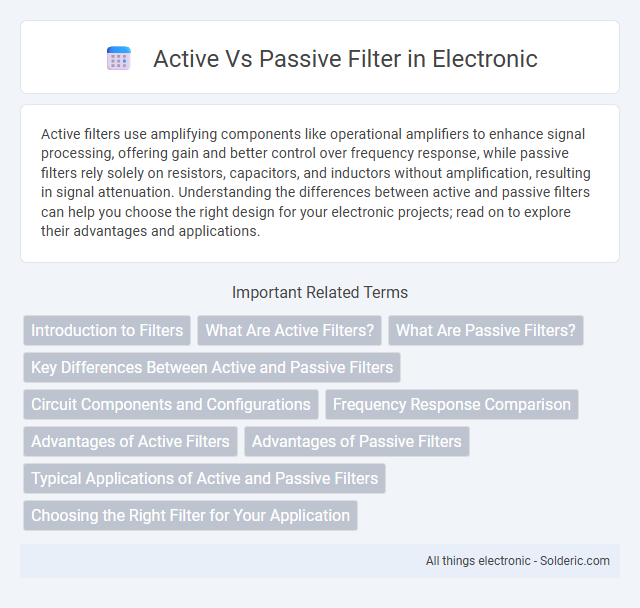Active filters use amplifying components like operational amplifiers to enhance signal processing, offering gain and better control over frequency response, while passive filters rely solely on resistors, capacitors, and inductors without amplification, resulting in signal attenuation. Understanding the differences between active and passive filters can help you choose the right design for your electronic projects; read on to explore their advantages and applications.
Comparison Table
| Feature | Active Filter | Passive Filter |
|---|---|---|
| Power Requirement | Requires external power supply | No power supply needed |
| Components | Uses active components like transistors or op-amps | Uses only resistors, capacitors, and inductors |
| Gain | Can provide signal gain | Cannot provide gain; only signal attenuation |
| Size and Weight | Typically larger and heavier due to active elements | Generally smaller and lighter |
| Frequency Range | Effective at low to medium frequencies | Effective at high frequencies, especially RF |
| Cost | Usually higher due to active components | Lower cost, simpler design |
| Complexity | More complex design and implementation | Simple, easy to design |
| Noise | May introduce noise from active devices | Passive components are noise-free |
Introduction to Filters
Filters separate signals based on frequency, with active filters using operational amplifiers, capacitors, and resistors to amplify and shape the output, while passive filters rely solely on passive components like resistors, capacitors, and inductors. Active filters provide gain, better input and output impedance matching, and greater design flexibility, making them suitable for applications requiring signal amplification. Passive filters are simpler, consume no power, and are often used in high-frequency applications where amplification is unnecessary or impractical.
What Are Active Filters?
Active filters use electronic components like operational amplifiers, resistors, and capacitors to amplify and shape signals without requiring inductors. They offer precise control over frequency responses such as low-pass, high-pass, band-pass, and band-stop characteristics, making them ideal for applications demanding high fidelity and stability. Your choice of an active filter ensures enhanced signal gain and flexibility compared to passive counterparts that rely solely on passive components.
What Are Passive Filters?
Passive filters are circuits composed solely of passive components such as resistors, capacitors, and inductors that are used to allow or block specific frequency ranges in electronic signals. They do not require an external power source to operate, relying on the natural properties of their components to attenuate or pass signals. Common examples include low-pass, high-pass, band-pass, and band-stop filters used in radio, audio, and communication systems for frequency selection and noise reduction.
Key Differences Between Active and Passive Filters
Active filters incorporate amplifying components like operational amplifiers, transistors, or integrated circuits, enabling signal gain and improved performance in frequency response. Passive filters consist solely of passive components such as resistors, capacitors, and inductors, relying on these elements to attenuate or pass specific frequency ranges without amplification. Key differences include power requirements, signal amplification capability, frequency range, and size, with active filters offering greater design flexibility and better precision in filtering applications.
Circuit Components and Configurations
Active filters utilize operational amplifiers, resistors, and capacitors to achieve desired frequency response with gain and low output impedance, enabling precise signal conditioning. Passive filters consist solely of resistors, capacitors, and inductors, relying on their inherent reactive properties without amplification, often resulting in signal attenuation. Your choice between active and passive filter configurations depends on factors like power availability, required signal gain, and circuit complexity.
Frequency Response Comparison
Active filters provide better frequency response control with the ability to amplify signals and achieve sharper cutoff slopes, enhancing selectivity and signal integrity. Passive filters rely solely on resistors, inductors, and capacitors, resulting in signal attenuation and less precise frequency response control. The gain and flexibility in tuning frequency response make active filters more suitable for applications requiring high performance and customization.
Advantages of Active Filters
Active filters offer significant advantages such as providing gain without the need for additional amplification components, enhancing signal strength directly. They enable precise frequency response control with easily adjustable parameters using operational amplifiers, resistors, and capacitors. Unlike passive filters, active filters have low output impedance, improving driving capability for subsequent stages and reducing signal distortion.
Advantages of Passive Filters
Passive filters offer advantages such as simplicity, reliability, and no need for external power sources, making them energy-efficient and cost-effective. Their design requires fewer components, leading to lower maintenance and longer lifespan due to the absence of active elements like transistors or op-amps. You benefit from passive filters' inherent stability and reduced noise interference in signal processing applications.
Typical Applications of Active and Passive Filters
Active filters are commonly used in audio processing, telecommunications, and medical devices due to their ability to amplify signals and provide precise frequency control. Passive filters find typical applications in radio frequency circuits, power supplies, and signal conditioning where simplicity, reliability, and low cost are crucial. Both filter types are essential in electronics, with active filters preferred for low-frequency signal manipulation and passive filters favored for high-frequency filtering and power handling.
Choosing the Right Filter for Your Application
Active filters use operational amplifiers along with resistors and capacitors to provide gain and precise frequency response, making them ideal for low-frequency applications requiring signal amplification. Passive filters rely solely on resistors, capacitors, and inductors without power supply, offering simplicity and reliability but limited to signal attenuation and no gain. Choosing the right filter depends on factors like desired frequency range, gain requirements, power availability, and circuit complexity, with active filters favored in audio processing and communication systems and passive filters preferred in high-frequency RF applications and rugged environments.
active vs passive filter Infographic

 solderic.com
solderic.com